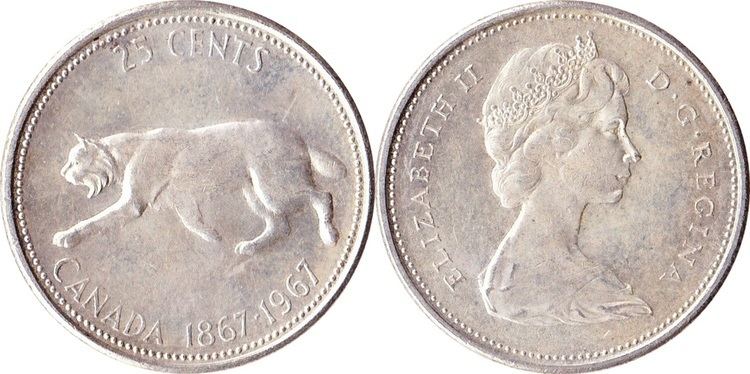Diameter 23.88 mm Edge Milled | Mass 4.4 g Thickness 1.58 mm | |
 | ||
Composition 94% steel,3.8% Cu,2.2% Ni plating | ||
The quarter, short for quarter dollar, is a Canadian coin worth 25 cents or one-fourth of a Canadian dollar. It is a small, circular coin of silver colour. According to the Royal Canadian Mint, the official name for the coin is the 25-cent piece, but in practice it is usually called a "quarter", much like its American counterpart. The coin is produced at the Royal Canadian Mint's facility in Winnipeg.
Contents
History of Composition
From 1920 until 1967 the quarter contained 0.15 troy ounces of silver -- 1/4 as much as the silver dollar (0.60 ozt), 1/2 as much as the 50 cent piece, and 2.5 times more than the dime.
Commemorative reverses
Ordinarily featuring a caribou, the quarter has the most commonly altered reverse in Canada, and is the usual venue for commemorative issues.
In 2004, a quarter was issued in honour of Remembrance Day, featuring a corn poppy on the reverse, a traditional symbol in Canada of that day. This resulted in a bizarre international incident, in which American military contractors unfamiliar with the coin's design believed these coins were outfitted with nanotechnology designed for espionage.
125th Anniversary of Confederation
In 1992, to celebrate the 125th anniversary of Confederation, the Mint released twelve commemorative coins, one for each Canadian province and territory at the time. These were the inspiration for the US 50 State Quarters program of 1999–2008. Nunavut, which separated from the Northwest Territories seven years later in 1999, was honoured with a special $2 coin.
Millennium quarters
In April 1998, the Mint announced the Millennium Coin Design Contest, a contest open to all Canadians to submit designs for twenty-four millennium quarters, one for each month of 1999 and 2000. The 1999 designs were meant to look back on Canada's past, while the 2000 designs looked to the future. While the 1999 coins were labeled with their month of issue, the 2000 coins were labeled with the relevant theme (see below).
Alberta and Saskatchewan Centennial
In 2005, to celebrate the centennials of the provinces of Alberta and Saskatchewan, two commemorative quarters were issued. The public was given the opportunity to vote on the coin design through two toll-free phone numbers.
There were four candidate designs for the Alberta quarter: Big Sky Country, Alberta’s Natural Beauty, A Dynamic Century, and Rocky Mountain Bighorn Sheep. The winning design was Big Sky Country, by Michelle Grant, and depicted an oil derrick with cattle grazing at its base. The coin had a mintage of 20,640,000.
There were three candidate designs for the Saskatchewan quarter: The Western Meadowlark, Canada Geese over Wascana Lake, and The Round Dance Celebration. The winning design was Western Meadowlark, designed by Paulette Sapergia. The coin's mintage was 19,290,000.
2010 Vancouver Olympics
The Olympic coins do not have the inscription 'D.G. Regina' (Latin for 'By the Grace of God, Queen') making the coins "godless circulating coins". There have been a couple of circulation strike mule coins in this series, including 2007 Paralympic wheelchair curling and 2009 Olympic Alpine Skiing coins. With the medalist coins now called the Olympic moments coins, a very small percentage will be a colorized version.
First strikes
Olympic first strikes
Canada Day
Since 2000, the RCM has been issuing colourized quarters on Canada Day with designs aimed to attract young collectors. As with other collector coins issued by the RCM, the Canada Day series coins are non-circulating legal tender.
Other notable dates
The Tooth Fairy and Friends
Starting in 2011, the mint began selling special sets for newborn babies, birthdays, wedding anniversaries, "Oh Canada" and the Tooth Fairy. The tooth fairy quarters also come packaged separately.
